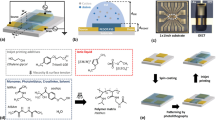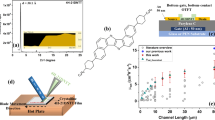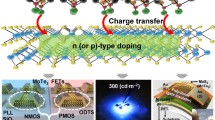Abstract
We demonstrate the fabrication of shadow mask (SM) patterned as well as nanoimprint lithography (NIL) patterned organic transistors and integrated complementary organic inverters (ICOIs). As active layers pentacene (p-type) and either PTCDI-C13H27 or F16CuPc (n-type) were used. The SM-patterned ICOIs with a staggered bottom gate configuration, a nanocomposite dielectric and both active layer combinations (pentacene/PTCDI C13H27, pentacene/F16CuPc) exhibited high performance (3 V operation voltage; gain around 60; high level 3 V; low level 5 mV; noise margin 0.9 V). Flexible ICOIs with transistor channel lengths of 900 nm were successfully fabricated by NIL, using a benzocyclobutene derivative as dielectric. Because of the process inherent coplanar bottom gate configuration, F16CuPc was used. The ICOIs showed proper functionality (3 V operation voltage; gain around 5; high level 2.9 V; low level 25 mV). To our knowledge, this study demonstrates the first complementary submicron inverters based on fully R2R compatible imprint processes.






Similar content being viewed by others
References
Y.L. Loo and I. McCulloch: Progress and challenges in commercialization of organic electronics. MRS Bull. 33(7), 653 (2008).
K. Myny, S. Steudel, S. Smout, P. Vicca, F. Furthner, B. van der Putten, A.K. Tripathi, G.H. Gelinck, J. Genoe, W. Dehaene, and P. Heremans: Organic RFID transponder chip with data rate compatible with electronic product coding. Org. Electron. 11, 1176 (2010).
M. Jung, J. Kim, J. Noh, N. Lim, C. Lim, G. Lee, J. Kim, H. Kang, K. Jung, A.D. Leonard, J.M. Tour, and G. Cho: All printed and roll-to-roll printable 13.56 MHz operated 1-bit RF tag on plastic foils. IEEE Trans. Electron Devices 57, 3 (2010).
T. Sekitani, M. Takamiya, Y. Noguchi, S. Nakano, Y. Kato, T. Sakurai, and T. Someya: A large-area wireless power-transmission sheet using printed organic transistors and plastic MEMS switches. Nat. Mater. 6, 413 (2007).
H. Klauk, M. Halik, U. Zschieschang, F. Eder, D. Rohde, G. Schmid, and C. Dehm: Flexible organic complementary circuits. IEEE Trans. Electron. Devices 52, 618 (2005).
D.J. Gundlach, K.P. Pernstich, G. Wilckens, M. Gruter, S. Haas, and B. Batlogg: High mobility n-channel organic thin-film transistors and complementary inverters. J. Appl. Phys. 98, 064502 (2005).
H. Klauk, D.J. Gundlach, and T.N. Jackson: Fast organic thin-film transistor circuits. IEEE Electron Device Lett. 20, 289 (1999).
U. Haas, H. Gold, A. Haase, G. Jakopic, and B. Stadlober: Submicron pentacene-based organic thin-film transistors on flexible substrates. Appl. Phys. Lett. 91, 043511 (2007).
C. Auner, U. Palfinger, H. Gold, J. Kraxner, A. Haase, T. Haber, M. Sezen, W. Grogger, G. Jakopic, J. R. Krenn, G. Leising, B. Stadlober: High-performing submicron organic thin-film transistors fabricated by residue-free embossing. Org. Electron. 11, 552 (2010).
C. Auner, U. Palfinger, H. Gold, J. Kraxner, A. Haase, T. Haber, M. Sezen, W. Grogger, G. Jakopic, J.R. Krenn, G. Leising, and B. Stadlober: Residue-free room temperature UV-nanoimprinting of submicron organic thin film transistors. Org. Electron. 10, 1466 (2009).
S.D. Vusser, S. Steudel, K. Myny, J. Genoe, and P. Heremans: Low voltage complementary organic inverters. Appl. Phys. Lett. 88, 162116 (2006).
Z. Bao, A.J. Lovinger, and J. Brown: New air-stable n-channel organic thin film transistors. J. Am. Chem. Soc. 120, 207 (1998).
C. Shen and A. Kahn: Electronic structure, diffusion and p-doping at the Au/F16CuPc interface. J. Appl. Phys. 90, 4549 (2001).
B. Crone, A. Dodapalapur, Y.Y. Lin, R.W. Filas, Z. Bao, A. LaDuca, R. Sarpeshkar, and H.E. Katz: Large-scale complementary integrated circuits based on organic transistors. Nature 403, 521 (2000).
H. Klauk, U. Zschieschang, J. Pflaum, and M. Halik: Ultralow-power organic complementary circuits. Nature 445, 745 (2007).
S. Tatemichi, M. Ichikawa, S. Kato, T. Koyama, and Y. Taniguchi: Low-voltage, high-gain, and high-mobility organic complementary inverters based on N, N’-Ditridecyl-3,4,9,10-Perylenetetracarboxylic diimide and pentacene. Phys. Status Solidi. 2, 47 (2008).
M. Zirkl, A. Haase, A. Fian, H. Schön, C. Sommer, G. Jakopic, G. Leising, B. Stadlober, I. Graz, N. Gaar, R. Schwödiauer, S. Bauer-Gogonea, and S. Bauer: Low-voltage organic thin-film transistors with high-k nanocomposite gate dielectrics for flexible electronics and optothermal sensors. Adv. Mater. 19, 2241 (2007).
L.L. Chua, P.K.H Ho, H. Sirringhaus, and R.H. Friend: High-stability ultrathin spin-on benzocyclobutene gate dielectric for polymer field-effect transistors. Appl. Phys. Lett. 84(17), 3400 (2003).
U. Haas, A. Haase, V. Satzinger, H. Pichler, G. Leising, G. Jakopic, B. Stadlober, R. Houbertz, G. Domann, and A. Schmitt: Hybrid polymers as tunable and directly-patternable gate dielectrics in organic thin-film transistors. Phys. Rev. B 73, 235339 (2006).
J. Kraxner, U. Palfinger, B. Stadlober, C. Auner, A. Haase, H. Gold, M. Belegratis, G. Jakopic, J.R. Krenn, and G. Domann: Ultra-thin hybrid dielectrics in sub μm NIL OTFTs. In Proceedings of the Seventh Organic Semiconductor Conference (London, United Kingdom, 2009).
U. Palfinger, C. Auner, H. Gold, A. Haase, J. Kraxner, T. Haber, M. Sezen, W. Grogger, G. Domann, G. Jakopic, J.R. Krenn, and B. Stadlober: Fabrication of n- and p-type organic thin film transistors with minimized gate overlaps by self-aligned nanoimprinting. Adv. Mater. 22, 5115 (2010).
A. Fian, A. Haase, B. Stadlober, G. Jakopic, N.B. Matsko, W. Grogger, and G. Leising: AFM, ellipsometry, XPS and TEM on ultra-thin oxide/polymer nanocomposite layers in organic thin film transistors. Anal. Bioanal. Chem. 390(6), 1455 (2008).
J. Jang, S.H. Kim, S. Nam, D.S. Chung, C. Yang, W.M. Yun, C.E. Park, and J.B. Koo: Hysteresis-free organic field-effect transistors and inverters using photocrosslinkable poly(vinyl cinnamate) as a gate dielectric. Appl. Phys. Lett. 92(14), 143306 (2008).
J. Rabaey, A. Chandrakasan, and B. Nikolic: Digital Integrated Circuits–—A design perspective, 2nd ed. (Prentice Hall Electronics and VLSI Series, Pearson Education Inc., London, 2003).
K. Hong, S.H. Kim, C. Yang, T.K. An, H. Cha, C. Park, and C.E. Park: Photopatternable, highly conductive and low work function polymer electrodes for high-performance n-type bottom contact organic transistors. Org. Electron. 12, 516 (2011).
K. Hong, S.H. Kim, C. Yang, J. Jang, H. Cha, and C.E. Park: Improved n-type bottom-contact organic transistors by introducing a poly (3,4-ethylenedioxythiophene):poly(4-styrene sulfonate) coating on the source/drain electrodes. APL. 97, 103304 (2010).
Acknowledgments
The authors are thankful for financial support from the Nanoinitiative Austria (FFG) since most of this work was done with NILaustria Cluster.
Author information
Authors and Affiliations
Corresponding author
Rights and permissions
About this article
Cite this article
Rothländer, T., Palfinger, U., Stadlober, B. et al. Nanoimprinted complementary organic electronics: Single transistors and inverters. Journal of Materials Research 26, 2470–2478 (2011). https://doi.org/10.1557/jmr.2011.282
Received:
Accepted:
Published:
Issue Date:
DOI: https://doi.org/10.1557/jmr.2011.282




